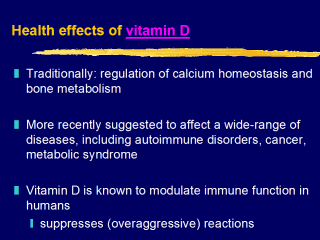| front |1 |2 |3 |4 |5 |6 |7 |8 |9 |10 |11 |12 |13 |14 |review |
 |
Although called
“a vitamin”, vitamin D is in fact a hormone, which is synthesized in the skin after
exposure to UV-B radiation from the sun. It can also be obtained thorough diet, although most foods contain only small amounts or no vitamin D. The main natural dietary source is fish, but the concentration varies between fish species and even between individual fish. Because the intake is often very low, some foods are fortified with small amounts of of vitamin D (e.g. margarine, milk). In many countries vitamin D supplementation is recommended for infants and other special groups which often have restricted intake (e.g. elderly individuals). It has been known for long time that vitamin D is essential for bone health, severe deficiency leading to rickets in children or osteomalasia in adults. During recent years scientific literature has suggested a wide-range of health effects for vitamin D, although only a few associations have been well demonstrated to date. Vitamin D receptors have been discovered from all over the body (e.g. immune-cells, brain, heart, pancreas, intestine) suggesting that vitamin D is likely to have some kind of function in these tissues. It is already known that vitamin D affects the immune system in humans. How would you measure vitamin D intake in an epidemiological study?
|